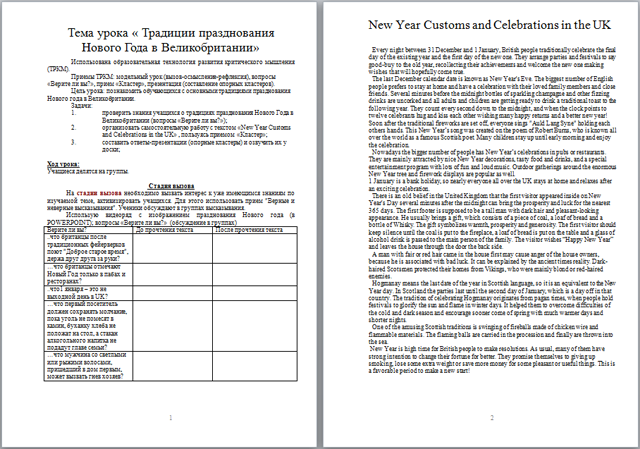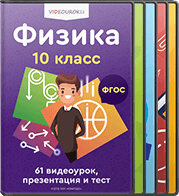Цель урока:
познакомить обучающихся с основными традициями празднования Нового года в Великобритании.
Задачи:
1. проверить знания учащихся о традициях празднования Нового Года в Великобритании (вопросы «Верите ли вы?»);
2. организовать самостоятельную работу с текстом «New Year Customs and Celebrations in the UK» , пользуясь приемом «Кластер»;
3. составить ответы-презентации (опорные кластеры) и озвучить их у доски;
Ход урока.
Учащиеся делятся на группы.
Стадия вызова.
На стадии вызова необходимо вызвать интерес к уже имеющимся знаниям по изучаемой теме, активизировать учащихся. Для этого использовать прием "Верные и неверные высказывания". Ученики обсуждают в группах высказывания.
Использую видеоряд с изображением празднования Нового года (в powerpoint); вопросы «Верите ли вы?» (обсуждение в группах)
New Year Customs and Celebrations in the UK.
Every night between 31 December and 1 January, British people traditionally celebrate the final day of the existing year and the first day of the new one. They arrange parties and festivals to say good-buy to the old year, recollecting their achievements and welcome the new one making wishes that will hopefully come true.
The last December calendar date is known as New Year's Eve.
The biggest number of English people prefers to stay at home and have a celebration with their loved family members and close friends.
Several minutes before the midnight bottles of sparkling champagne and other fizzing drinks are uncorked and all adults and children are getting ready to drink a traditional toast to the following year.
They count every second down to the midnight, and when the clock points to twelve celebrants hug and kiss each other wishing many happy returns and a better new year! Soon after the traditional fireworks are set off, everyone sings "Auld Lang Syne" holding each others hands.
This New Year’s song was created on the poem of Robert Burns, who is known all over the world as a famous Scottish poet. Many children stay up until early morning and enjoy the celebration.
Nowadays the bigger number of people has New Year’s celebrations in pubs or restaurants. They are mainly attracted by nice New Year decorations, tasty food and drinks, and a special entertainment program with lots of fun and loud music. Outdoor gatherings around the enormous New Year tree and firework displays are popular as well.
1 January is a bank holiday, so nearly everyone all over the UK stays at home and relaxes after an exciting celebration.

There is an old belief in the United Kingdom that the first visitor appeared inside on New Year's Day several minutes after the midnight can bring the prosperity and luck for the nearest 365 days.
The first footer is supposed to be a tall man with dark hair and pleasant-looking appearance. He usually brings a gift, which consists of a piece of coal, a loaf of bread and a bottle of Whisky.
The gift symbolizes warmth, prosperity and generosity. The first visitor should keep silence until the coal is put to the fireplace, a loaf of bread is put on the table and a glass of alcohol drink is passed to the main person of the family. The visitor wishes “Happy New Year” and leaves the house through the door the back side.
A man with fair or red hair came in the house first may cause anger of the house owners, because he is associated with bad luck.
It can be explained by the ancient times reality. Dark-haired Scotsmen protected their homes from Vikings, who were mainly blond or red-haired enemies.
Hogmanay means the last date of the year in Scottish language, so it is an equivalent to the New Year day.
In Scotland the parties last until the second day of January, which is a day off in that country. The tradition of celebrating Hogmanay originates from pagan times, when people hold festivals to glorify the sun and flame in winter days. It helped them to overcome difficulties of the cold and dark season and encourage sooner come of spring with much warmer days and shorter nights.
One of the amusing Scottish traditions is swinging of fireballs made of chicken wire and flammable materials.
The flaming balls are carried in the procession and finally are thrown into the sea.
New Year is high time for British people to make resolutions. As usual, many of them have strong intention to change their fortune for better.
They promise themselves to giving up smoking, lose some extra weight or save more money for some pleasant or useful things. This is a favorable period to make a new start!
Стадия осмысления.
На этой стадии необходимо сохранить интерес учащихся к теме при непосредственной работе с текстом. Использую:
Метод «Кластеры»
Это способ графической организации материала, позволяющий сделать наглядными те мыслительные процессы, которые происходят при погружении в ту или иную тему. Кластер является отражением нелинейной формы мышления. Иногда такой способ называют «наглядным мозговым штурмом».
Последовательность действий проста и логична:
1. Посередине чистого листа (классной доски) написать ключевое слово или предложение, которое является «сердцем» идеи, темы.
2. Вокруг «накидать» слова или предложения, выражающие идеи, факты, образы, подходящие для данной темы. (Модель «планеты и ее спутники»)
3. По мере записи, появившиеся слова соединяются прямыми линиями с ключевым понятием. У каждого из «спутников» в свою очередь тоже появляются «спутники», устанавливаются новые логические связи.
В итоге получается структура, которая графически отображает наши размышления, определяет информационное поле данной теме.
В работе над кластерами необходимо соблюдать следующие правила:
Весь материал - в документе.

 Получите свидетельство
Получите свидетельство Вход
Вход






 Пример кластера
Пример кластера
























 Разработка урока по английскому языку «Традиции празднования Нового года в Великобритании» (24.37 КB)
Разработка урока по английскому языку «Традиции празднования Нового года в Великобритании» (24.37 КB)
 0
0 457
457 20
20 Нравится
0
Нравится
0


